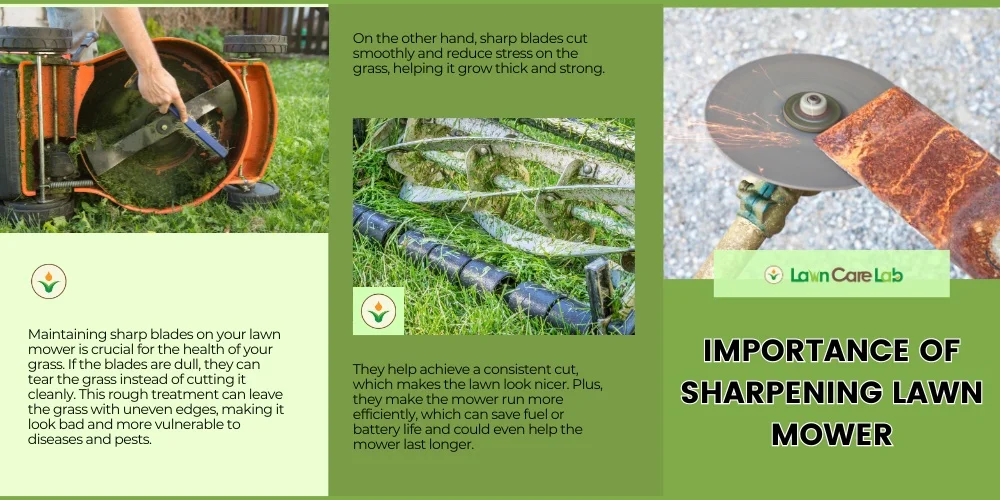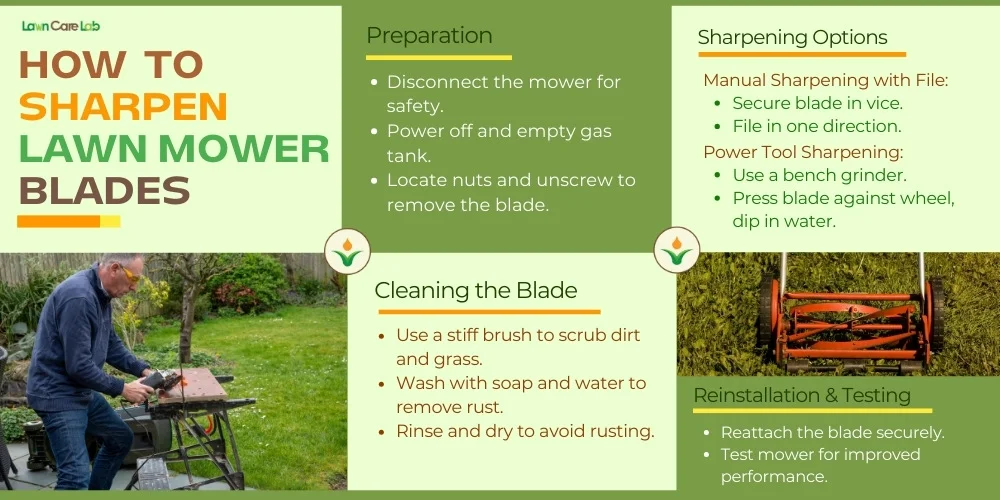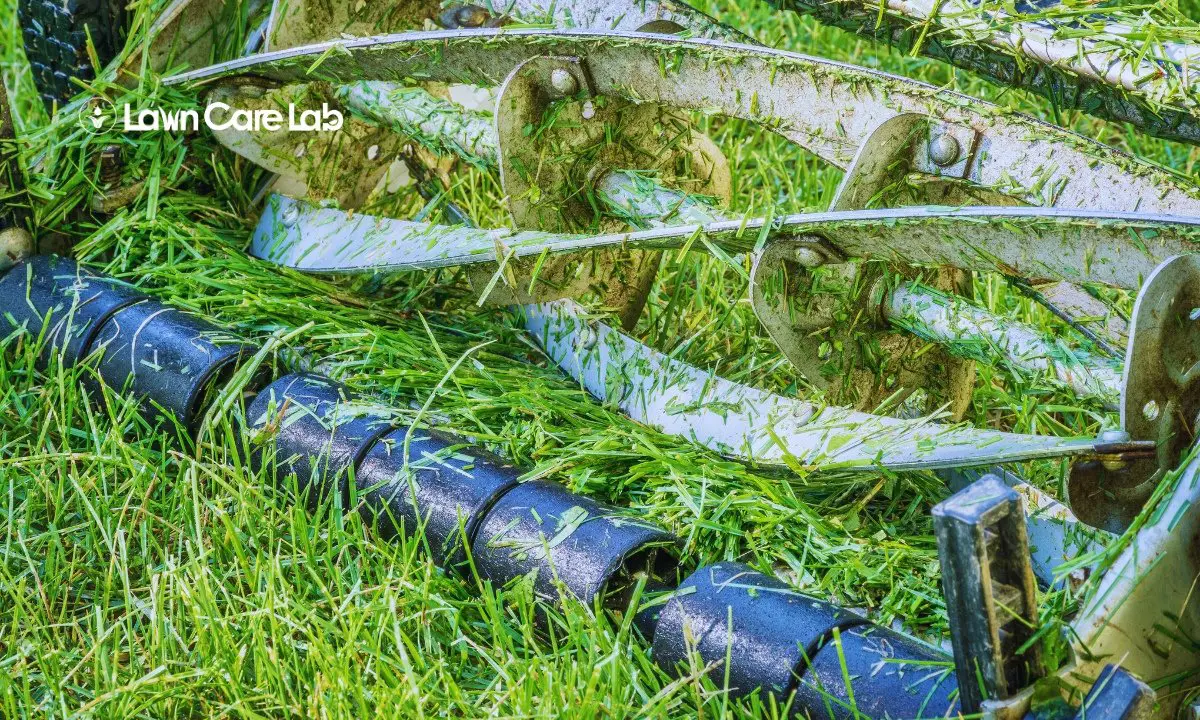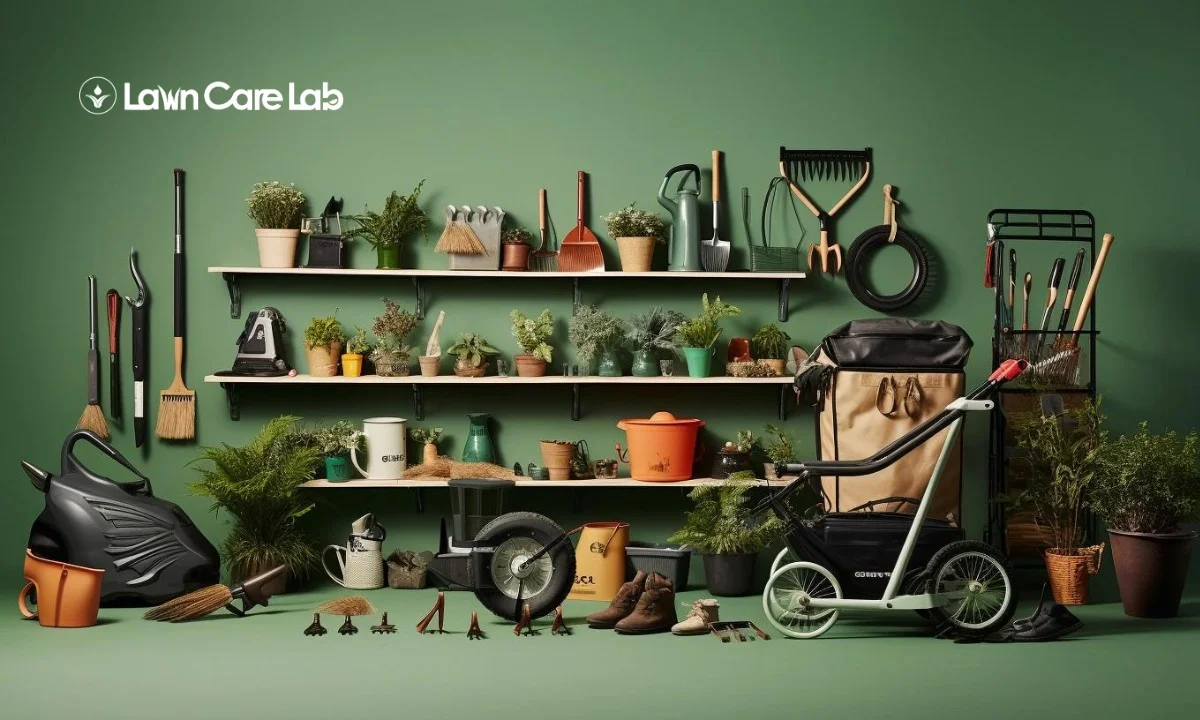Keeping your lawn mower blades sharp is essential for maintaining a healthy, vibrant lawn. Dull blades can tear grass, leaving it with jagged edges that lead to discoloration and make your lawn more susceptible to diseases.
By sharpening your mower blades regularly, you ensure cleaner cuts, reduce stress on the grass, and help it grow stronger.
This guide will explain when to sharpen your blades, the tools you’ll need, and how to safely sharpen and balance them for optimal performance.
Regular maintenance of your mower blades can make all the difference in achieving a lush, beautiful lawn year-round.
Table of Contents
Importance of Sharpening Lawn Mower Blades
Maintaining sharp blades on your lawn mower is crucial for the health of your grass. If the blades are dull, they can tear the grass instead of cutting it cleanly. This rough treatment can leave the grass with uneven edges, making it look bad and more vulnerable to diseases and pests.
On the other hand, sharp blades cut smoothly and reduce stress on the grass, helping it grow thick and strong.

Besides improving the health of your lawn, sharp blades also make your mower work better. They help achieve a consistent cut, which makes the lawn look nicer. Plus, they make the mower run more efficiently, which can save fuel or battery life and could even help the mower last longer.
Remember to always be safe when checking and sharpening the blades.
For example, regularly using a blade sharpener can keep your mower’s blades in top condition. It’s an easy-to-use tool that ensures your mower is always ready for the job, making your lawn care routine smoother and more effective.
How to Know When Your Lawn Mower Blades Need Sharpening
To know if your mower blades need sharpening, inspect the grass after mowing. If the grass looks torn, uneven, or has yellow tips, it’s a sign the blades are dull and need sharpening.
Regularly sharpening the blades ensures a healthier, cleaner cut and prevents lawn damage.
For best results, after every 25 hours of mowing, consider sharpening the blades. This simple maintenance can help prevent lawn damage and keep your mower running efficiently.
Signs of Dull Lawn Mower Blades
If your grass looks uneven or has rough edges after you cut it, your lawn mower blades might be dull.
When your mower is less effective, taking longer or needing several tries to cut the grass well, it’s a sign that the blades need sharpening.
Sharp blades cut cleanly and efficiently, making your mowing quicker and easier.
Visual Clues on Grass Blades
After mowing, check the grass blades. If the edges are rough or torn, it means your mower blades are dull.
Sharp blades produce smooth, clean cuts, promoting healthier grass growth.
Decreased Mower Efficiency and Performance
When a mower requires multiple passes to cut evenly or seems to struggle, the blades may need sharpening.
Dull blades reduce efficiency and can cause uneven cuts, so sharpening them regularly will improve both mower performance and lawn appearance.
Regular maintenance, such as cleaning the blades after each use and checking them for wear, can also help prolong their sharpness and effectiveness.
Tools Required for Sharpening Lawn Mower Blades
To sharpen your lawn mower blades, secure the blade with a vice and use either a metal file or a bench grinder. Wear safety goggles and gloves to protect yourself. These tools and precautions ensure safe, efficient sharpening and help maintain your mower’s performance.
- File or Bench Grinder: A metal file allows for manual sharpening with greater control, while a bench grinder speeds up the process for quicker results. Both tools are effective but should be used with caution to maintain the blade’s sharpness and ensure safety.
- Protective Gear for Safety: Always wear safety goggles to protect your eyes from flying debris, and use gloves to protect your hands from sharp edges. These precautions help ensure that you can sharpen the blades without risking injury.
How to Sharpen Lawn Mower Blades
Once your tools are ready, start by disconnecting the mower for safety. Clean the blade to remove dirt and grass.

Use a manual file or power grinder to sharpen the blade, sliding the file in one direction or applying steady pressure with the grinder.
After sharpening, reattach the blade securely and test the mower. This improves blade performance and extends the mower’s life.
Removing the Blade Safely
Before you sharpen your lawn mower’s blade, it is crucial to remove it safely. First, ensure the mower is completely turned off to prevent it from accidentally starting. If your mower is gas-powered, empty the gas tank to avoid any spills or potential fires.
Here is a straightforward step-by-step guide to help you remove the blade safely:
| Step | Action |
|---|---|
| 1. Power Off | Make sure the mower is fully turned off. |
| 2. Drain Gas | Empty the gas tank if your mower uses gasoline. |
| 3. Locate Nuts | Look for the nuts that hold the blade in place. |
| 4. Unscrew | Unscrew the nuts carefully to detach the blade. |
Cleaning the Blade Before Sharpening
Before you sharpen the lawn mower blade, make sure it’s clean. First, take a stiff brush and scrub off all the dirt, grass, and debris. Cleaning the blade first helps ensure the sharpening process is accurate.
Next, mix some mild dish soap with water and use this solution to wash the blade, removing any leftover dirt and rust. Remember to wear gloves to protect your hands from the sharp edges of the blade.
After washing, rinse the blade with clean water and dry it thoroughly to avoid rust. This careful cleaning helps make the sharpening process more effective, which means your lawn mower will work better.
Sharpening Process: Manual and Power Tools Options
When it comes to sharpening your lawn mower blades, you essentially have two choices: manually using a file or using a power tool like a bench grinder.
If you value accuracy and are okay with taking a bit more time, opting for a file is ideal. This method allows for meticulous control, ensuring each blade is sharpened precisely.
| Sharpening Process | Manual Sharpening with a File | Using a Bench Grinder for Faster Sharpening |
|---|---|---|
| Tool | Metal file | Bench Grinder |
| Speed | Slower, requires more time | Faster, quick results |
| Precision | High, allows meticulous control and accuracy | Moderate, depends on movement control |
| Steps | 1. Secure blade. 2. Press the blade against the grinder wheel. 3. Move slowly to sharpen evenly. 4. Dip the blade in water to prevent overheating. | 1. Secure blade. 2. Press the blade against the grinder wheel. 3. Move slowly to sharpen evenly. 4. Dip the blade in water to prevent overheating. |
| Advantages | Better control over the sharpening process | Much faster and still effective |
| Considerations | Time-consuming but precise | Requires attention to overheating (cool by dipping in water) |
On the other hand, if you’re pressed for time and want quick results, a bench grinder is the way to go. It’s much faster and still delivers effective sharpening.
For those who prefer the bench grinder method, consider the Dewalt DW758, which is known for its durability and performance.
Blade Balancing: Why It Matters
Balancing your lawn mower blade is crucial after sharpening it. This step helps avoid uneven wearing and reduces vibrations, which can strain the mower’s engine and cutting parts.
Here’s how to balance your blade effectively:
First, make sure the blade is clean. Any debris can affect the balance. Next, you can use a simple tool like a blade balancer or even a nail in the wall to check the balance. Hang the blade on the nail and see if it tilts. If one side dips, it’s heavier and you need to file it down slightly.
Repeat this process until the blade stays horizontal.
This careful balancing act ensures your mower operates smoothly, extends its lifespan, and protects its parts from unnecessary stress.
How to Balance a Lawn Mower Blade After Sharpening
Once you’ve sharpened your lawn mower blade, make sure it’s balanced.
This step is crucial because an unbalanced blade leads to vibrations and uneven grass cutting.
To check balance, you can use a specialized tool called a blade balancer.
Alternatively, you can hang the blade on a nail placed through its center hole.
Achieving balance helps your mower operate smoothly and keeps your lawn looking even.
Simple Balance Testing Techniques
Ensuring that your lawn mower’s blade is balanced is crucial for optimal mower performance and a healthy lawn.
Here is a straightforward method to check the balance of your mower blade:
- Set the blade on a balancer. This tool helps you see if the blade is evenly weighted.
- Watch for balance. A balanced blade will remain horizontal. If it tilts, it’s off-balance.
- Make adjustments. If one side is heavier, carefully file down that side until it balances.
It’s important to balance your blade to prevent uneven cuts and excess wear on the mower.
Always focus on safety and accuracy when handling mower blades.
How Often Should You Sharpen Your Lawn Mower Blades?
To determine when to sharpen your lawn mower blades, consider the size of your lawn and how often you mow.
It’s generally recommended to sharpen the blades once each mowing season or after every 25 hours of use. This ensures your mower cuts grass effectively and keeps your lawn looking healthy.
Regular sharpening helps your mower work better and makes it last longer. For example, if you have a large yard that you mow weekly, check the blades mid-season to see if they need a touch-up.
Using a trusted blade sharpener, such as the Work Sharp Knife & Tool Sharpener, can make this maintenance task easier.
Seasonal Guidelines Based on Lawn Size and Usage
It’s important to keep your lawn mower blades sharp to ensure your lawn stays healthy and your mower works efficiently.
Here’s an easy guide on when to sharpen your blades based on your lawn’s size and usage:
- Small Lawns (mowed weekly): Sharpen blades once at the beginning of the season. Smaller lawns mean less wear on the blades.
- Medium to Large Lawns (mowed weekly): Sharpen your blades twice during the season to keep cuts clean and reduce stress on the mower.
- High Usage (mowed multiple times a week): Sharpen the blades monthly to avoid damaging the grass and the mower’s blades.
Following these tips helps ensure your lawn looks great and extends the life of your mower.
For example, using a blade sharpener like the ‘GardenSharp Tool Sharpener’ can make this maintenance task easier and more effective.
Maintaining Sharp Blades for Healthier Lawns
To keep your lawn looking great, it’s important to check and maintain your mower blades regularly.
Every time you mow, inspect the blades for damage or dullness.

After mowing, clean off any grass clippings and dry the blades to prevent rust.
Storing your mower in a dry area will also help avoid blade deterioration.
Regular Inspection Tips
It’s crucial to regularly check the blades of your lawn mower to ensure your lawn stays healthy. Sharp blades cut grass cleanly, which is essential for the health of your lawn.
Here’s a simple guide to inspecting your mower’s blades:
- Inspect for Damage: Look closely at the blade’s edge for any small nicks or chips. These flaws can result in tearing the grass instead of cutting it cleanly, which may cause your lawn to turn brown and look unhealthy.
- Test for Sharpness: Gently press your thumb across the blade, moving perpendicular to the edge, to check if it’s still sharp. Avoid touching the blade directly along the edge as it’s unsafe.
- Look for Signs of Aging: Check if the blade is bent or appears thinner than usual, signs that it might be time for a replacement to prevent it from breaking during use.
Proper Blade Storage After Use
After each time you mow the lawn, it’s important to clean and dry your mower blades properly. This helps keep them sharp and stops them from rusting.
After cleaning, spray the blades with a rust-preventive product. This step helps protect them from rust, which can make the blades dull.
Store the blades in a place that’s dry and safe. Keeping them in a dry area is crucial because even a little moisture can cause rust, which weakens the blades and can be unsafe.
Storing them properly not only makes your blades last longer but also ensures they’re ready and safe for the next time you mow, helping you get a clean and healthy cut.
For example, after drying the blades, you can use a product like WD-40 to coat them. This helps in keeping the blades in good condition for your next use.
Common Mistakes to Avoid When Sharpening Lawn Mower Blades
Sharpening your lawn mower blades incorrectly can cause a lot of issues with your mowing. Here’s how to do it right and keep your lawn looking its best:
- Avoid Over-Sharpening: Sharpening the blade too much can make it too thin, which weakens it and shortens its life. You should only remove enough metal to make the edge sharp again.
- Check the Balance: It’s important to ensure that the blade is balanced after sharpening. A blade that isn’t balanced properly can make your mower vibrate, which might damage it or cause uneven cutting.
- Inspect Blades Regularly: Don’t wait until the blade is completely dull. Check and sharpen the blades regularly to keep them cutting well without too much effort.
Frequently Asked Questions
Can Dull Blades Affect the Growth Rate of My Lawn?
Are Sharpened Blades Safer to Use Than Dull Ones?
Can I Sharpen Ceramic Mower Blades the Same Way as Metal?
Is There an Ideal Season for Sharpening Lawn Mower Blades?
- How to Create a Lawn Care Schedule for Southern Climates - October 30, 2024
- How to Use Compost Tea to Boost Lawn Growth and Soil Health - October 23, 2024
- The Best Grasses for Saltwater-Exposed Lawns: Coastal Lawn Care - October 17, 2024



